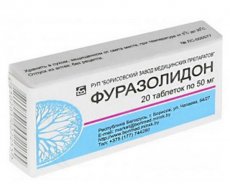Medical expert of the article
New publications
Preparations
Furazolidone
Last reviewed: 03.07.2025

All iLive content is medically reviewed or fact checked to ensure as much factual accuracy as possible.
We have strict sourcing guidelines and only link to reputable media sites, academic research institutions and, whenever possible, medically peer reviewed studies. Note that the numbers in parentheses ([1], [2], etc.) are clickable links to these studies.
If you feel that any of our content is inaccurate, out-of-date, or otherwise questionable, please select it and press Ctrl + Enter.

Release form
The medicine is produced in tablets, which are yellow or yellow-green in color, flat-lindrical in shape and chamfered. Each tablet for abdominal pain is packaged in a blister pack of ten pieces and placed in a cardboard box of one or ten packages, supplied with a leaflet with instructions. The tablets can also be packaged in a blister pack and placed in a cardboard box of one, two, five, fifty or one hundred packages, accompanied by a leaflet with instructions.
Each tablet contains fifty milligrams of the active substance furazolidone, as well as a certain amount of auxiliary substances: lactose monohydrate, colloidal silicon dioxide anhydrous, calcium stearate, potato starch.
Pharmacodynamics
The drug shows antimicrobial and antiprozoal action. It has a bacteriostatic effect on microorganisms. The action of Furazolidone is based on the disruption of the activity of the functioning of the enzyme system of the bacterium.
Furazolidone affects staphylococci and streptococci, gram-positive bacteria - E. coli, Shigella, Enterobacter, Proteus, Klebsiella, Salmonella, as well as protozoa from the genus Giardia. Intestinal bacteria that cause dysentery, typhoid fever and paratyphoid fever are highly sensitive to the drug. The development of drug resistance in these bacteria occurs slowly.
Pharmacokinetics
The active substance Furazolidone is characterized by weak absorption into the blood and loses its effectiveness in the intestine. About five percent of the drug can be excreted from the body through urine in an untransformed form or in the form of metabolites. In this case, the patient's urine becomes brown.
Dosing and administration
Furazolidone is taken orally, after meals, washed down with water. Adults use two to three tablets four times a day, with a course of treatment lasting from five to ten days. The single maximum dosage is two hundred milligrams of the drug, and the daily dosage is eight hundred milligrams.
Children over five years of age take half a tablet or a tablet four times a day.
The course of treatment with the drug cannot be longer than ten days.
Use Furazolidone during pregnancy
The medication is prohibited for use during pregnancy and breastfeeding.
Contraindications
- Presence of hypersensitivity to substances Furazolidone.
- The appearance of terminal stage renal failure in the chronic form of the disease.
- Presence of glucose-6-phosphate dehydrogenase deficiency.
- The patient's age is under five years.
- Do not prescribe if an infection occurs that affects the urinary tract.
Side effects Furazolidone
The appearance of nausea, vomiting, loss of appetite.
The occurrence of allergic reactions in the form of exanthema and enanthema.
Sometimes there is a hypersensitivity reaction, which is characterized by decreased blood pressure, the appearance of urticaria and arthralgia, and an increase in body temperature. When the medication is canceled, all of the above reactions pass.
In some cases, headaches and symptoms of general malaise may occur, which disappear if the dose of Furazolidone is reduced or the drug is discontinued.
Some patients may experience a disulfiram-like reaction to alcohol consumption, which includes flushing of the skin, slight increase in body temperature, shortness of breath, and a feeling of tightness in the chest.
To reduce side effects, you need to wash down the medicine with a large amount of water or reduce the dosage. It is also necessary to use antihistamines, calcium chloride and B vitamins.
If the side effects do not disappear, Furazolidone should be discontinued.
Overdose
Interactions with other drugs
Furazolidone is a drug that blocks the production of monoamine oxidase. Therefore, it should be used with caution, as with other drugs in this group.
The action of aminoglycosides and tetracyclines leads to an increase in the antimicrobial effects of Furazolidone.
Increased sensitization of the body occurs when drinking alcohol.
The medication helps suppress hematopoiesis if taken together with Chloramphenicol and Ristomycin.
Storage conditions
Furazolidone - stored in a place protected from moisture and light, as well as from children at a temperature of up to 25°C.
 [ 39 ]
[ 39 ]
Attention!
To simplify the perception of information, this instruction for use of the drug "Furazolidone" translated and presented in a special form on the basis of the official instructions for medical use of the drug. Before use read the annotation that came directly to medicines.
Description provided for informational purposes and is not a guide to self-healing. The need for this drug, the purpose of the treatment regimen, methods and dose of the drug is determined solely by the attending physician. Self-medication is dangerous for your health.

